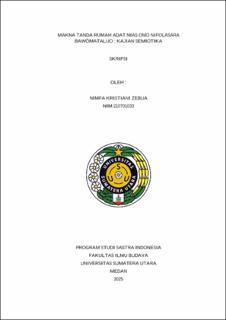Makna Tanda Rumah Adat Nias Omo Nifolasara Bawömataluo Kajian Semiotika Ferdinand de Saussure
The Meaning Of Signs In The Nias Traditional House Omo Nifolasara Bawömataluo: A Semiotic Study

Date
2025Author
Zebua, Nimfa Kristiani
Advisor(s)
Mulyadi, Mulyadi
Ritonga, Parlaungan
Metadata
Show full item recordAbstract
This study examines the meaning of signs embodied in the ornaments of the traditional Nias house, Omo Nifolasara, located in Bawömataluo Village. Motivated by the declining knowledge among younger generations regarding the symbolic significance of traditional ornaments, this research emphasizes the importance of scientific documentation for preserving local cultural heritage. Utilizing a qualitative method and Ferdinand de Saussure’s semiotic framework—which distinguishes between the signifier (the visual form of the ornament) and the signified (the cultural concept)—this study aims to: (1) identify the forms and types of ornaments in Omo Nifolasara; (2) analyze the meaning embedded in each sign; and (3) explore the dynamics of interpretation, particularly concerning the shifts or loss of meaning among today’s generation. Initial findings indicate that ornaments such as simbi (pig jaw), rai högo (king’s crown), asu (dog), bae (monkey), kiliwi (lizard), lasara (mythological creature), and dala’ӧ mbanua (front hearth) are not merely decorative elements but carry values of honor, protection, intelligence, strength, and harmony passed down through generations. Thus, Omo Nifolasara functions not only as a dwelling but also as a symbolic communication space reflecting the cultural identity of the Nias people.
Collections
- Undergraduate Theses [617]
